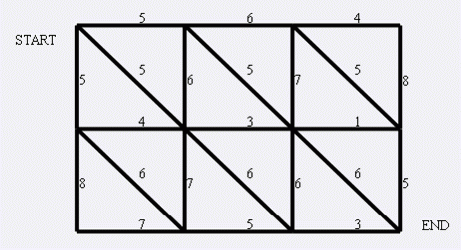狼抓兔子(平面图转对偶图)
面对下面这样一个网格的地形:
道路上的权值表示这条路上最多能够通过的兔子数,道路是无向的. 左上角和右下角为兔子的两个窝,开始时所有的兔子都聚集在左上角(1,1)的窝里,现在它们要跑到右下角(N,M)的窝中去,狼王开始伏击这些兔子.当然为了保险起见,如果一条道路上最多通过的兔子数为K,狼王需要安排同样数量的K只狼,才能完全封锁这条道路,你需要帮助狼王安排一个伏击方案,使得在将兔子一网打尽的前提下,参与的狼的数量要最小。因为狼还要去找喜羊羊麻烦。
没什么好说的,放张图就知道了:

#include <queue>
#include <cstdio>
#include <vector>
#include <cstring>
using namespace std;
const int maxn=3e6, INF=1e9;
int n, m, src, dst;
struct Edge{
int to, nxt, v;
}e[maxn*2];
int fir[maxn], cnte;
void addedge(int x, int y, int v){
Edge &ed=e[++cnte];
ed.to=y; ed.nxt=fir[x]; ed.v=v; fir[x]=cnte;
Edge &ed2=e[++cnte];
ed2.to=x; ed2.nxt=fir[y]; ed2.v=v; fir[y]=cnte;
}
int dis[maxn], num[maxn];
struct cmp{
bool operator ()(int x, int y){ return dis[x]>dis[y]; }
};
priority_queue<int, vector<int>, cmp> q;
int dijkstra(){
for (int i=1; i<=dst; ++i) dis[i]=INF;
int u, v; q.push(src); num[src]=1;
for (int i=0; i<=dst; ++i){
while (num[q.top()]>1) --num[q.top()], q.pop();
u=q.top(); q.pop(); --num[u];
for (int j=fir[u]; ~j; j=e[j].nxt){
v=e[j].to;
if (dis[u]+e[j].v<dis[v]){
dis[v]=dis[u]+e[j].v;
++num[v]; q.push(v);
}
}
}
return dis[dst];
}
int main(){
memset(fir, -1, sizeof(fir));
scanf("%d%d", &n, &m); int t; src=0; dst=n*m+1;
for (int i=1; i<m; ++i){ scanf("%d", &t); addedge(src, i*2, t); }
for (int i=1, cur=1; i<n-1; ++i)
for (int j=1; j<m; ++j, cur+=2){
scanf("%d", &t);
addedge(cur, cur+2*m-1, t);
}
for (int i=1; i<m; ++i){ scanf("%d", &t); addedge(dst-2*(m-i), dst, t); }
for (int i=1, cur=2; i<n; ++i){
scanf("%d", &t); addedge(cur-1, dst, t);
for (int j=1; j<m-1; ++j, cur+=2){
scanf("%d", &t);
addedge(cur, cur+1, t);
}
scanf("%d", &t); addedge(0, cur, t); cur+=2;
}
for (int i=1, cur=1; i<n; ++i)
for (int j=1; j<m; ++j, cur+=2){
scanf("%d", &t); addedge(cur, cur+1, t); }
printf("%d
", dijkstra());
return 0;
}
